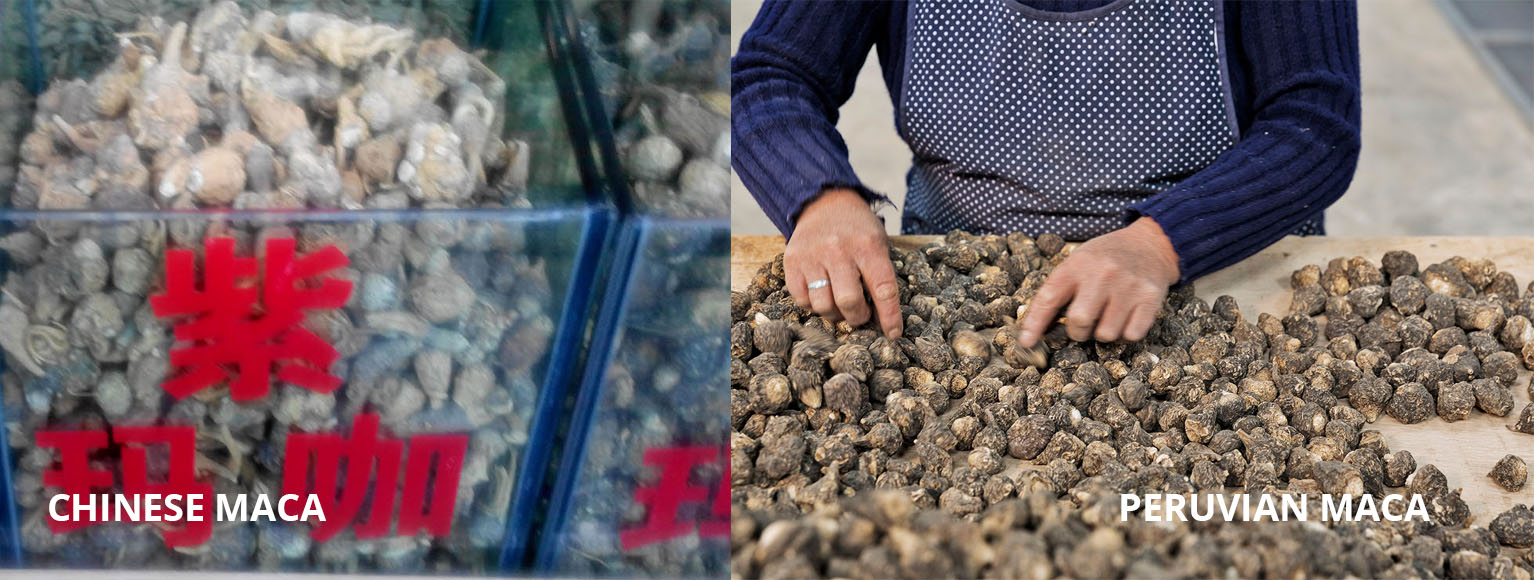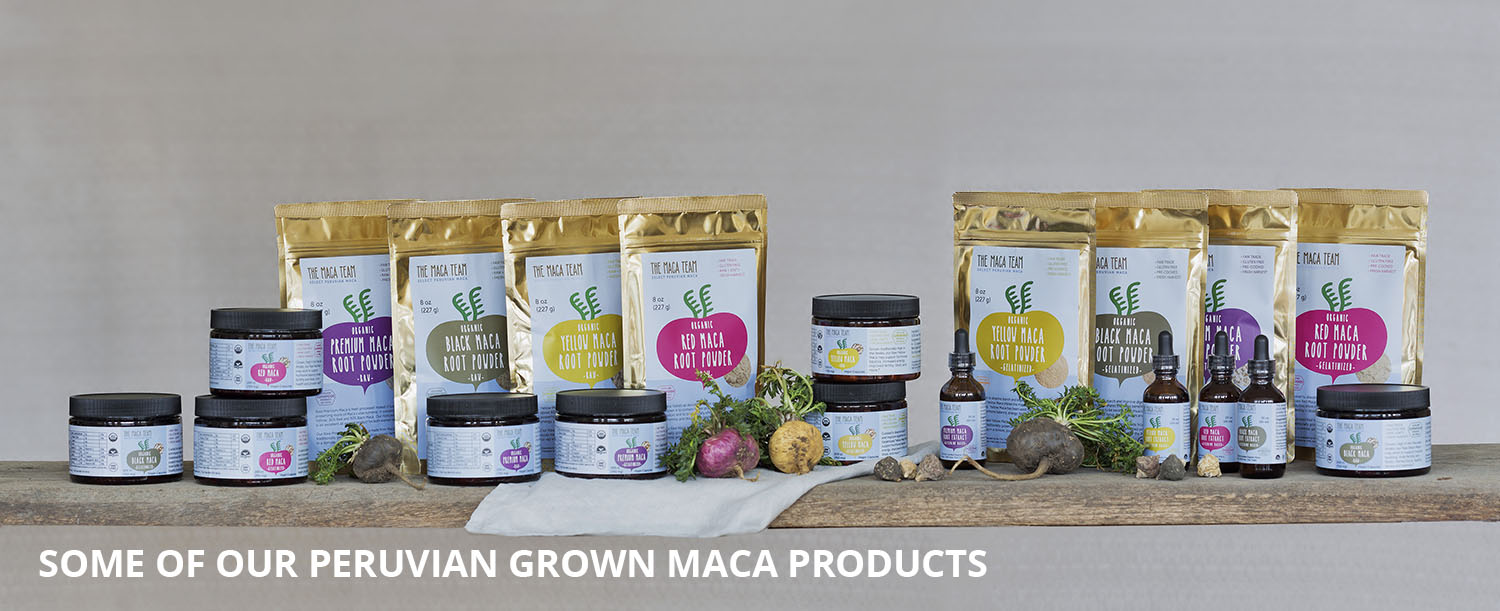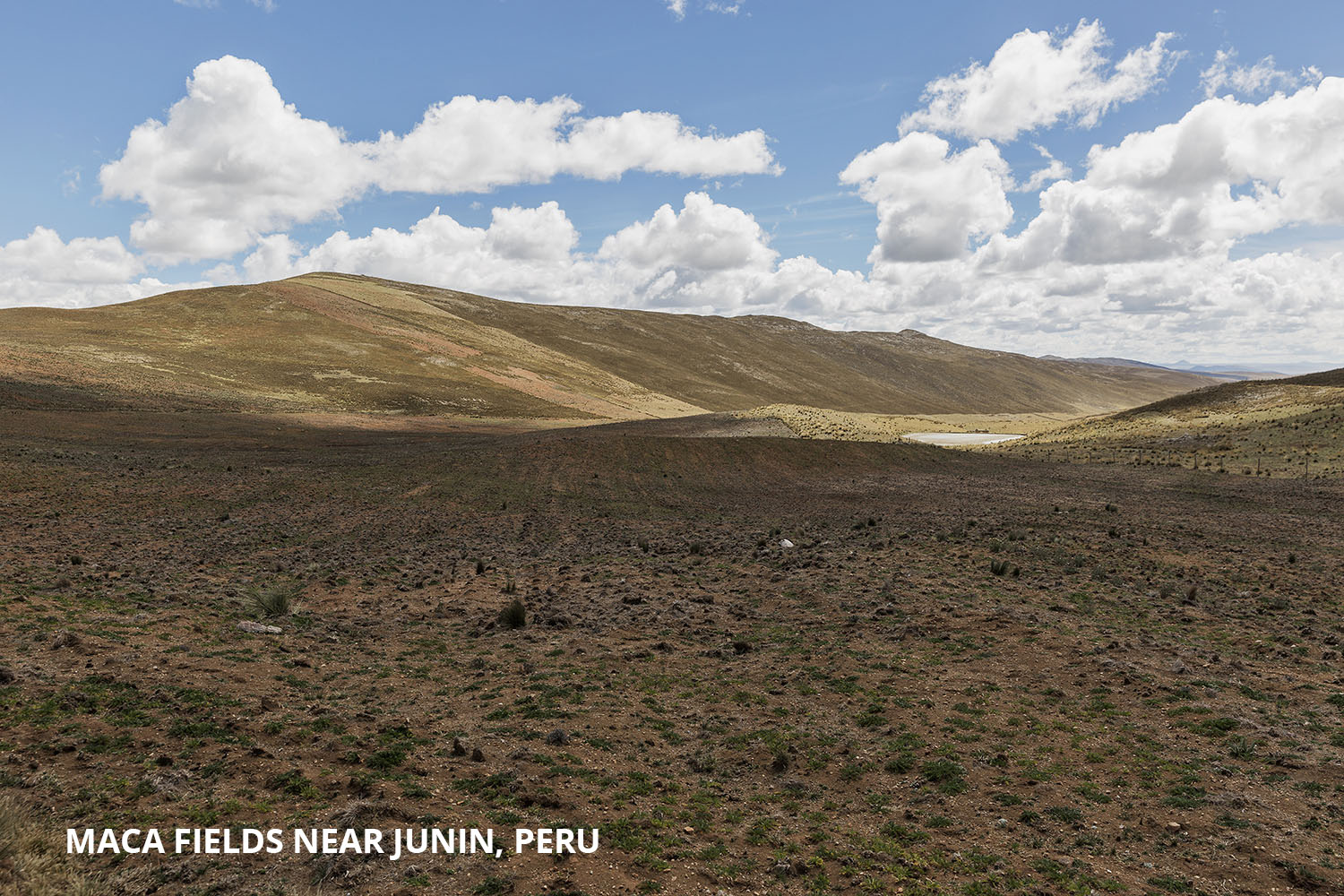Peruvian Maca
Introduction
If you would like to learn about Peruvian Maca, to understand what makes it superior, and to discover where and how to purchase it, you’re in the right place. This article is all about authentic, potent, and effective Maca products grown in Peru. For the past 20 years, we here at The Maca Team have had 100% of our focus on all aspects of this amazing superfood and are happy to share our knowledge and experience with you. For your convenience, we've divided this article into several key sections. Just click the topic you are interested in below to dive right into it. If you are new to Peru’s most nutritionally dense food, we recommend that you carefully read through the entire article, which will help you understand the benefits of maca and why the Peruvian variety is the only one worth using. It’s an investment that’s worth your time since it will help you experience more success when you decide to add any Maca product from Peru to your daily diet.
- The Extraordinary Story Of Maca
- Where Maca Really Comes From
- Can Maca Be Grown Oustide of The Andes?
- Why It’s Important To Use Only Maca That Comes From Peru
- Where Can I Buy Authentic High Quality Peruvian Maca?
- What Types Of Maca Are There?
- What Kind Of Maca Is Best For Me?
- What Can Maca Do For You?
- How To Get The Most Out Of Taking Maca
- Conclusion
The Extraordinary Story Of Maca
Would you believe that as recently as the late 1980s, a renown Peruvian researcher published a book in which he warned that Maca might soon be extinct? This once mighty food of the gods, which had been cultivated for nearly 10,000 years, had been demanded in tribute by Incan rulers and revered by Spanish soldiers and generals, had, by that time, fallen into all-time production lows. 
Why would such a valuable food find itself so marginalized? The answer, in part, lies in the modernization of Peru. As more and more people left the high Andes for the promise of a better life of the capital city Lima, the demand for Maca within Peru plummeted. In order to adapt themselves to their new-found urban surroundings, most native highlanders abandoned familiar ancestral staple foods like Maca and Quinoa. These were seen as “poor people’s” foods and many individuals were even ashamed to eat them. Outside of a few doctors and alternative health practitioners, relatively few people in Lima even knew about Maca in the 1980s. And even in the heart of the Maca production zone of Junin, many young people were quickly abandoning the traditions of their ancestors, including the cultivation and consumption of this simple, yet nutritionally dense staple of the region.
The situation remained largely unchanged until the mid 1990s when Luis Castillo, a young law student from the Junin area, emigrated to Japan in search of work. On his journey to Japan Mr. Castillo brought his favorite home-grown food: Maca. The story goes that the Japanese carpenters with whom Mr. Castillo worked with noticed how strong and energetic he was. When asked what his “secret” was, he told them about Maca. The Japanese workers immediately wanted to try it to and Mr. Castillo began bringing small amounts of the root into Japan. It worked for them as well, and shortly thereafter he moved back home and began a business to produce and export Maca to Japan.
At roughly the same time (late 1990s) more naturopathic and alternative doctors began promoting the benefits of Maca in North America and Europe. Because of the efficacy of the so-called “Peruvian ginseng” as a functional food, it gained in popularity and production increased. That meant that more and more people in the Junin area returned to cultivating Maca on their ancestral lands. So much so, that by 2015 Maca was one of the largest superfood export crops in Peru.
Where Maca Really Comes From
Based on the historical and archaeological records available to us the consensus is that Maca originated in the high Andes of Peru around the province of Junin. Like many other tubers and roots, this cruciferous vegetable grew natively and wildly in the high mountains surrounding lake Chinchaycocha (a.k.a. lake Junin). This very large (529.88 km2 or 204.59 sq mi) lake’s presence is important because it creates a micro-climate that generates more annual precipitation, allowing native plants to grow easily. Scientists postulate that the first human settlers in the area, the Pumpush, discovered that Maca roots were a good source of food as early as 10,000 years ago. And archaeological researchers have discovered ancient roots in a cave several kilometers east of the lake and date them from this era. They suggest this as evidence that wild Maca roots were gathered and used as a main source of food during this time. This is certainly the earliest evidence we have of the use of Maca and places its origin clearly in a region northeast of the modern-day town of Junin, in a region called Ondores. Several locals also confirm that in their oral tradition Ondores is considered the “birth place” of Maca.
Can Maca Be Grown Oustide of The Andes?
It wasn’t until the 1843 that Maca was officially classified and catalogued. German researcher Wilhelm Gerhard Walpers collected early samples of the plant which he eventually called lepidium meyenii Walp. Since that time researchers have attempted to grow the plant outside of the high mountains on several occasions with varying levels of success.
- European Maca - Seeds were taken to Germany in the early 20th century in an effort to grow and further study the plant. While the Maca seeds did sprout and the leaves did grow, the root simply did not form fully or properly. Since the root is the important nutritional part of the plant, efforts to study it were shifted back to Peru.
- Maca from Lima – similarly, in the 1960s, Dr. Gloria Chacon, the leading researcher on the benefits of Maca supervised several attempts to grow the plant at around sea level in Lima. Again, while the seeds sprouted and the leaves grew, the roots did not form fully or properly. This led to the conclusion that Maca must be grown at higher elevations to derive its full benefits.
- Californian Maca – attempts to grow the Maca plant at higher elevations in California met with mixed results. While the plant did grow and did form somewhat of a tuber, this tuber was much smaller and less nutritionally dense than the Maca from the Junin area
- Argentine Maca – Maca seeds have also been brought for cultivation to the mountains of Argentina, but, although the roots did form, the resulting nutritional potency of the plant has been deemed unsatisfactory for human consumption. In fact, the only other place that the plant can be grown with some success, even in the Andes, is in Bolivia
- Chinese attempts to grow Maca – In 2013 Chinese entrepreneurs illegally exported Maca seeds from Peru and a large scale. They sold them to farmers in China who planted them at high elevation in the Yunaan province. Farmers did produce some very inferior Maca. It was so poor that even local Chinese people refused to buy much of it. Subsequently, speculators attempted to flood the world market with it. Not surprisingly, these Chinese grown products did not work very well. As a company, we’ve had 100s of customers complain of the low potency and quality of Maca they purchased from Costco, Wallgreens or other large outlets. When we’ve asked them to share the country of origin on the label, more often than not it’s been China. Fortunately for the world of Maca fans, the farmers of the Yunaan province in China have largely abandoned their efforts to produce Maca. That said, it’s still important to read labels to verify the origin of any product you purchase. You can read more here about the 2013 Chinese Maca crisis and the unfortunate effects it has had on farmers throughout Peru.

Why It’s Important To Use Only Maca That Comes From Peru
Based on the section above, you can get a clear initial idea of why it’s important to source only high-quality Peruvian maca. The first and foremost reason to purchase Maca that comes from the highlands of Peru is that it simply works the best based on the research that has been conducted. Over the years, we’ve tried all sorts of Maca from all kinds of different places and without exception, the Maca from organic and traditional farms around the Junin area of Peru works the best. This of course makes perfect sense given that these lands are the native lands of the original wild plant. Another great reason to purchase Maca powder and other products only from Peru is that all of Peru is Non-GMO. That means there are no GMOs applied to the cultivation of the plant whatsoever. Note that China, in contrast, has applied for as many as 7 patents for GMOs for this root. From a broader perspective, Maca is considered to be a heritage product of Peru and is protected under Peruvian and international law as such. Anyone or any country wishing to grow Maca outside of the high Andes should legally obtain permission from the Peruvian government before doing so. This is a law that Peru does enforce as evidenced by the illegality of exporting either whole roots or seeds of the plant. Finally, but not least, purchasing quality Maca from Peru supports farmers who are invested in growing it properly and who take pride in carrying on the tradition of this amazing food. Maca requires very specific conditions and treatment to grow properly and can’t be grown on the same lands more than 2 years in a row. The land must then be rested for about 10 years afterward, in order for it to produce nutritious crops of the root again. Traditional farmers know this and follow this and other holistic ecological practices when growing Maca.
Where Can I Buy Authentic High Quality Peruvian Maca?
This is a great question. The first thing is to look at the label. Any quality brand will list the country of origin of its product. If you don’t see the origin listed, we recommend not purchasing it. Interestingly, not all suppliers even know where their Maca comes from. A second question to ask is when the Maca was packaged. Some brands package their Maca months and even years before it is sold (the powder does have a 3 year self-life). Also look to see how it’s packaged. T he powder should be in an air-tight, sealed, completely dark container for maximum potency. We’d also encourage you to ask what region of Peru this particular Maca was grown and harvested in. The most effective, without doubt, comes from the Junin area. Of course, we do hope that you’ll consider purchasing products from our family run business, The Maca Team. On this website, you’ll find the largest selection of high quality Maca from Peru anywhere. We work with organic farming co-operatives around Junin who treat the land as it should be treated and who grow the best Maca we’ve ever tried.
What Types of Maca are there?
This simple root grows in a range of colors from light gray to deep maroon. Locals have identified up to 40 different ecotypes of the root. But for all processing and research purposes the roots are divided into 4 categories.
- Yellow Maca – ranging from off white to golden is the most common color accounting for about 65% of the harvest
- Red Maca – ranging from light pink to dark red is the second most common accounting for about 20%
- Black Maca – ranging from light to dark gray is the rarest at about 15%
- Mixed Color Maca -the most traditional type where all three colors are simply mixed at harvest
Each of these colors have been studied and, though genetically nearly identical, each has somewhat different effects or specialties. We recommend looking into our in-depth articles on the subject. Also, you may be interested in our proprietary blend of all 3 colors of Maca to get the benefits of all three in one.
Beyond the colors, it’s important to note that Maca roots is processed in various ways for consumption. The closest to the whole root which we are legally allowed to bring from Peru are Maca chips. These are essentially the whole maca root cut into chunks and are great for making porridges and soups and teas and traditional dishes from the Andes such as Mazamorra de Maca. The most common presentation of the root for consumption comes in the form of Maca powder. To make it, the roots are ground very finely to create a powder that is easily absorbed by the body. Many people use it in their smoothies, shakes and even for cooking. For those who don’t like the taste of the root, Maca is available in capsule form as well. Although more expensive, they are very convenient to take. Finally, we offer a liquid maca extract that is tasty and easy to take with you on the go.
What Kind Of Maca Is Best For Me?
This is a great question and one that we often receive from our customers. Equally important as the color and presentation of the product you decide to use, is the quality. Before purchasing any product make sure that the factors that make Maca the most potent are present:

- Where was this product grown? Obviously, you want that to be Peru
- From what year harvest is it? Maca is harvested once a year in Peru, generally from April – July. Here, fresher is better
- How recently was the product processed? The more recent the better
- How carefully and in what kind of container has the product been packaged.
Once you’ve found a brand of products that fulfill these qualifications it’s time to decide what kind of Maca is best for you. By far the best way to do that is to use one of our two tools that you can find here
What Can Maca Do For You?
This is where the topic of Maca root products gets really interesting. After all, most people interested in adding it to their daily diet are profoundly interested in the effects of Maca. Because it contains several unique plant compounds (including amino acids called macaenes and macamides) that work on the hormone level, Maca root has shown, in clinical trials as well as in everyday use to have a number of beneficial results for both men and women.
Before listing some of the most prominent of these, it's important to understand that Maca root is a food and not a drug, herb or even supplement. It takes time to work in the body (we recommend at least 4 weeks of consistent use to see initial benefits) and it may not work for everyone in the same way. None of the information here is intended to substitute for medical advice nor to treat any health condition. Please consult your doctor as needed. Now let's look more carefully at what people get from Maca.
Fertility - The origin story of Maca suggests that it was first dissovered early settlers to the area who noticed that their livestock who consumed it had more and healthier offspring. People have since reported Maca supporting their own process of conception. Here is a letter we received recently:
"My husband has a varicocele and has had many semen analysis tests completed in the past. We have done IUI 4 times in the past year, the first 3 his sperm counts (after wash) was a total of 1.8-2.4 million with about 60% or less motility. He had been taking clomid to improve his count. In December he started your black maca (6 capsules per day), we had a new test done this week and his daily sperm production count was 19.4 million with 85% motility! This was amazing and totally shocking. The only thing that changed from the previous tests was the maca. We did not end up pregnant from that round of IUI. But a few months later we did! My husband had actually stopped the clomid but continued the Maca and we became pregnant naturally, without any medical intervention. This is was a complete shock given we had been trying naturally for over 5 years. Black maca in our case truly helped us conceive."
Menopause - Because taking Maca in any of it's forms has a positive effect on hormone levels, it's not surprising that menopausal symptoms have shown a decrease in women using it consistently. A few of the specific symptoms such as night sweats, irritablity and hot flashes tend to decrease over time. Here's a comment from a customer happy with her results:
"This stuff is amazing. I am peri-menopause. I had taken flax seed for the night sweats but it seems to no longer help much. My menstrual cycle was crazy. I did some research on Maca and which one would be best for me. So, I ordered the red maca and after 3 weeks WOW. No more sweating at night and my menstrual cycle is back to normal, then fewer. I am not having any of the symptoms of menopause. No emotional outburst, no hot flashes and fewer menstrual cycles. The taste isn't great but I just add it to my smoothie every morning and it's drinkable. The benefits are worth it. I highly recommend this product to everyone. It has worked for me." -K. Patterson
Prostate Health - Several customers have reported this type of benefit as have a rat study done in Peru. It's important to note that Red Maca was used in the study, although men have reported similar results with other colors. Read this from one of our customers:
"I have a May December marriage . My husband was diagnosed with prostate cancer 6 years ago. While in Peru visiting friends, we were introduced to maca and another wonderful elixir called algarroba . We started taking both religiously He has made a full recovery and I have aged extremely well he is 75 and still teaching kindergarten physical Ed and I am 51 and extremely active enjoying my family. Thank God for making such wonderful things and the maca team for bringing it home." - -- Carmen Federico
Building Muscle Mass - Maca has long been a favorite of natural bodybuilders and athletes alike. It is anabolic, meaning that it does promote muscle growth. That is, as long as the person taking it is actively using his or her muscles.
Promoting Sexual Health - Unfortunately, there is a lot of misinformation from unscrupulous sources claimng that Maca can work to cure erectile dysfunction. While it does work as an aphrodisiac for many people and can improve sexual desire for both females and males, in and of itself it does not work like a "viagra." That said, lots of people do have positive results from adding Maca to their diet and it is certainly worth trying over solutions such as artificial testosterone supplements or more invasive procedures.
Depression - This is one of our favorite benefits of adding this simple food into our lives. Even with a dose of just 1 tablespoon per day, the founder of this website and company saw a significant improvement in his dysthymia (low level depression) after just a few weeks. It is in fact what inspired him to share the product with more and more people originally. It's not surprising since Maca, like other adaptogens, works to raise overall life force energy.
”I purchased MACA after a friend suggested it. I was having hormonal issues and libido issues, it took the MACA several weeks to kick-in,’ BUT when it did; my life was forever changed. I encourage people to give it time to balance their issues’ out, and then enjoy their new life I stopped taking Celexa (anti-depressant) and feel way better on MACA than I ever did on CelexaPLUS, it helps with my libido and the Celexa (along with most anti-depressants) inhibited my libido. I’ve had such AMAZING results, I’ve had numerous friends order it and RAVE about their own results. I’m a LIFE buyer of MACA because of the MAJOR positive results I’ve experienced!! -- Heather Martin
These are the top benefits of taking Maca from Peru, and we've catalogued many others. Please visit our Maca benefits page to see more.
How To Get The Most Out Of Taking Maca
Now that you know more than most people about this simply amazing food, here are a few tips to get the most out of adding it to your life.

- Make sure that you get a great, organic product grown in Peru
- Be patient since it takes time to work in the body. Make sure to have enough to take for at least one month
- Be consistent. Daily use of Maca, especially at the beginning is helpful in getting the best results possible. After the first month or so, we do recommend taking 1 day off per week.
- Have fun with it. We have a complete selection of Maca Recipes on our site to make adding it to special dishes fun and easy
- Know that more benefits might come later. For example, let's say you are taking Maca to imporve sexual dysfunction, you might also find later that your testosterone levels (for men) or estrogenic levels (for women) are improved
- Make sure your getting the right one for you.
Conclusion
Thank you for taking the time to read this article. We hope that you've enjoyed it. If you are now ready to choose one of our Maca products, click here for a couple of great tools that will help you find out which Maca is best for you. As a small family run company we're also always happy to help. Please reach out via phone or email and we'll gladly do so.
Ready to add the amazing superfood to your life? Buy Maca Here
Enjoy the day!
![]()
